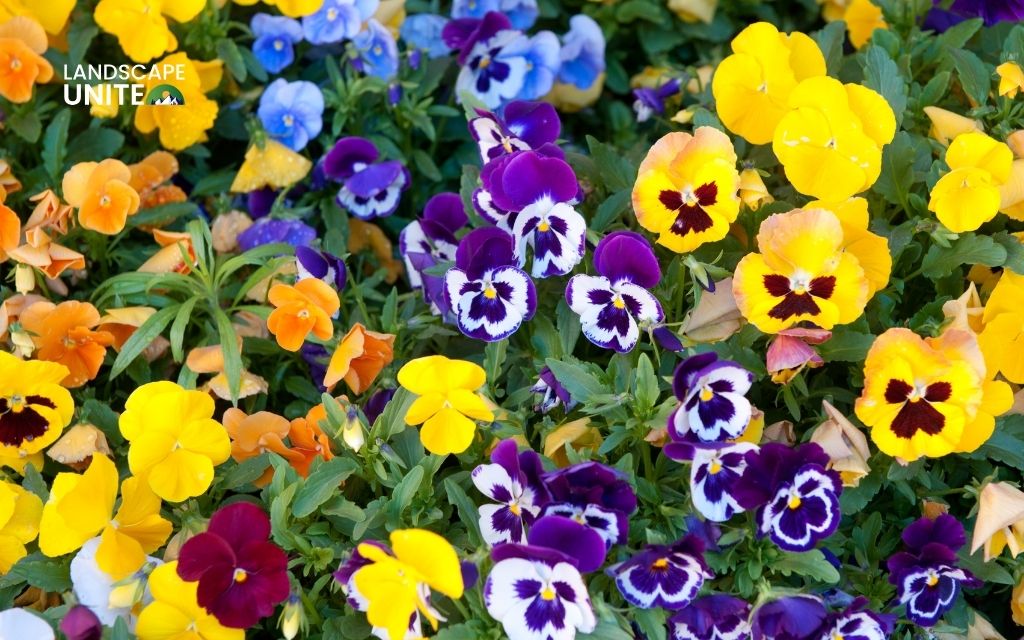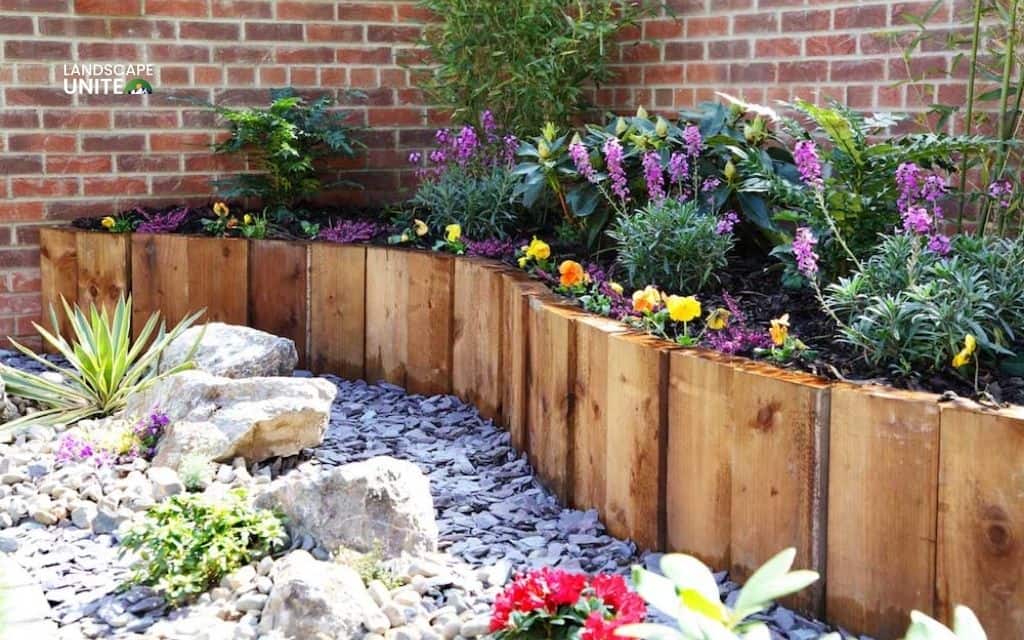Are you tired of replacing wood mulch every year? You’re not alone. More homeowners across the United States are discovering the benefits of rock mulch landscaping ideas that combine beauty with practicality.
Traditional wood mulch requires constant replacement and attracts pests. Rock mulch offers a permanent solution that conserves water, reduces maintenance, controls erosion, and provides fire-resistant landscaping. These advantages make rock and mulch landscaping ideas increasingly popular among busy homeowners.
Ready to transform your outdoor space? Here are 10 stunning landscaping ideas with rocks and mulch that will give your property lasting curb appeal while reducing your yard work.
Top 10 rock and mulch landscape ideas
1. Curved gravel beds with hardy perennials
Create flowing garden borders using pea gravel as your base material. Plant drought-tolerant perennials like yarrow, penstemon, or lavender directly through the gravel. This front yard landscaping idea with rocks and mulch requires minimal watering and provides year-round structure.
The key is choosing the right plant spacing. Leave 18-24 inches between plants to allow for mature growth while the gravel suppresses weeds naturally.
2. River rock borders around garden beds
Define your planting areas with clean river rock edges. This landscaping idea with mulch and rock creates sharp contrast between different zones in your yard. Use 2-3 inch river rocks to frame traditional mulched beds containing your favorite shrubs and flowers.
This approach works especially well for homeowners who want to keep some organic mulch for moisture-loving plants while gaining the durability of stone borders.
3. Mulch-to-rock transitions for slope control
Prevent erosion on hillsides by transitioning from organic mulch at the top to larger crushed stone lower down the slope. Add anchor boulders at strategic points to create visual interest and provide additional stability.
This rock and mulch landscaping idea works particularly well in regions with heavy rainfall or snow melt. The rocks handle water flow while the upper mulch area supports plant growth.
4. Rock mulch under trees with mulch accent rings
Replace traditional tree rings with decorative rock mulch, then add a small circle of organic mulch directly around each trunk. This creates an attractive contrast while giving you the best of both materials.
The rock mulch prevents weeds and lasts for years, while the organic mulch near the trunk provides nutrients as it decomposes. This technique works beautifully for both large shade trees and smaller ornamental varieties.
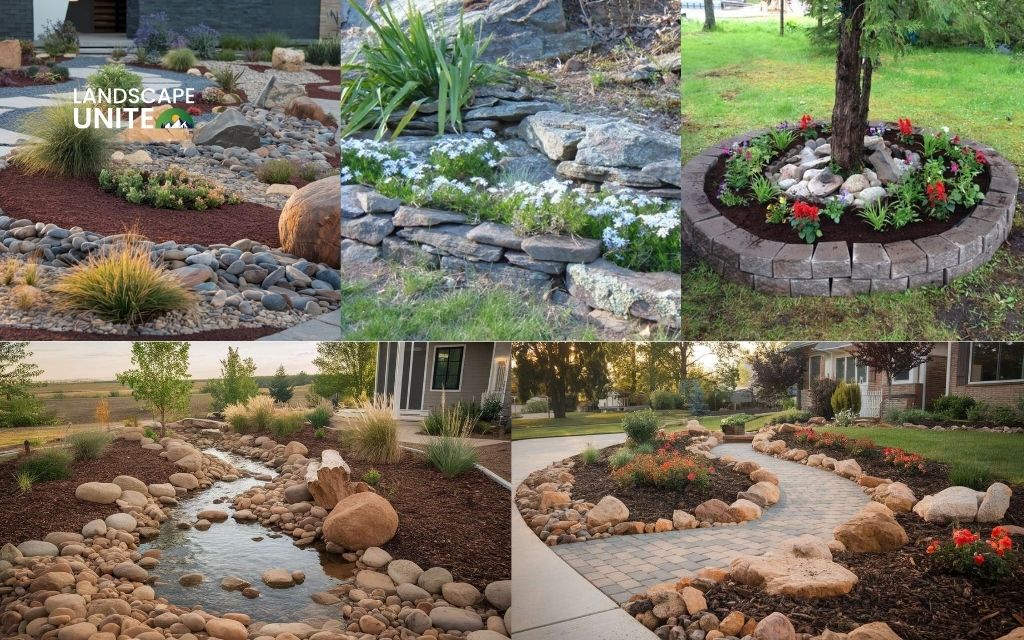
5. Dry creek bed with mixed rock sizes and mulch edges
Design a natural-looking drainage feature using various sizes of river rock and gravel. Blend organic mulch along the outer edges where you’ll plant moisture-loving perennials and grasses.
This mulch and rock landscaping idea solves drainage problems while creating a focal point in your yard. During dry periods, it looks like a decorative dry streambed. When it rains, it functions as intended for water management.
6. Flagstone paths with gravel fill and mulch plant pockets
Combine stepping stones with clean pea gravel filler and small planting pockets filled with organic mulch. This creates walkways that feel natural while providing designated areas for colorful flowers or herbs.
Leave 12-inch square pockets between stones for plants. Fill these areas with quality organic mulch to support plant growth while the surrounding gravel provides drainage and weed control.
7. Front yard island bed with boulders, mulch and decorative rock mix
Create a stunning focal point using large boulders as anchor points, decorative rock mulch for the main area, and organic mulch in specific planting zones. This rock and mulch landscaping idea for front yard designs provides maximum visual impact.
Choose boulders that complement your home’s architecture. Surround them with medium-sized decorative stones, then add organic mulch only where you’re growing plants that benefit from organic matter.
8. Raised rock beds with dark bark mulch for contrast
Build raised planting beds using light-colored retaining stones, then fill them with dark organic mulch. This creates striking visual contrast while providing excellent growing conditions for your plants.
The raised design improves drainage naturally, while the organic mulch supports healthy plant growth. This approach works well for vegetable gardens, herb gardens, or ornamental flower beds.
9. Xeriscape tree ring using lava rock and ornamental grass
Surround existing trees with red or black lava rock, then plant drought-tolerant ornamental grasses directly through the rock mulch. This landscaping idea with rocks and mulch creates a modern, water-wise landscape that thrives in hot climates.
Lava rock is lightweight and provides excellent drainage. The irregular texture adds visual interest while the ornamental grasses provide movement and seasonal color changes.
10. Fire-smart perimeter beds with gravel and mulch-free zones
Create defensible space around your home using gravel mulch within 5 feet of structures, then transition to organic mulch in outer planting areas. This river rock and mulch landscaping idea provides fire safety while maintaining beautiful gardens.
Choose light-colored gravel near buildings to reduce heat absorption. Plant fire-resistant native plants in the outer mulched areas to create a graduated landscape that’s both beautiful and practical.
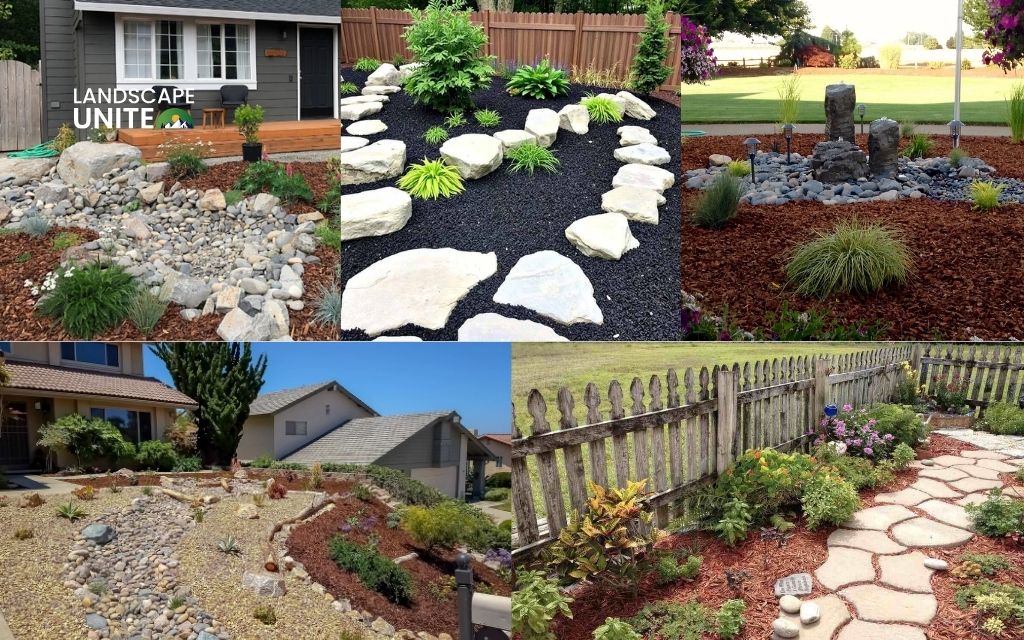
What is rock mulch and how it differs from wood mulch
Rock mulch consists of various stone materials used to cover soil surfaces, suppress weeds, and create attractive landscape designs. Unlike organic wood mulch, rock mulch provides permanent ground cover that doesn’t decompose or require replacement.
Key differences between rock and organic mulch
- Lifespan and durability: Rock mulch lasts indefinitely with minimal maintenance, while wood mulch needs replacement every 1-2 years.
- Water management: Organic mulch retains moisture for plant roots, while rock mulch provides excellent drainage and prevents overwatering.
- Fire resistance: Stone materials don’t burn, making them ideal for fire-prone regions. Organic mulch can fuel fires during dry conditions.
- Maintenance requirements: Rock mulch stays in place and resists wind displacement. Wood mulch may blow away or wash out during storms.
Popular rock mulch types for landscaping
- Pea gravel: Small, rounded stones perfect for pathways and ground cover. Available in various colors.
- Decomposed granite: Compactable material that creates solid surfaces while allowing some water penetration.
- River rock: Smooth, rounded stones in various sizes. Excellent for drainage areas and decorative borders.
- Lava rock: Lightweight, porous stones that provide good drainage and unique texture. Available in red and black varieties.
5 Tips for choosing rock and mulch pairings that work
1. Use color contrast and texture balance
Pair light-colored stones with dark organic mulch for maximum visual impact. Smooth river rocks complement chunky bark mulch beautifully. Consider your home’s exterior colors when selecting materials.
2. Follow fire safety guidelines
Keep organic mulch at least 5 feet away from structures in fire-prone areas. Use rock mulch in this defensible space zone to reduce fire risk while maintaining attractive landscaping.
3. Consider drainage requirements
Match your mulch choice to plant needs. Use rock mulch around succulents and drought-tolerant plants that prefer excellent drainage. Reserve organic mulch for moisture-loving species like ferns and hostas.
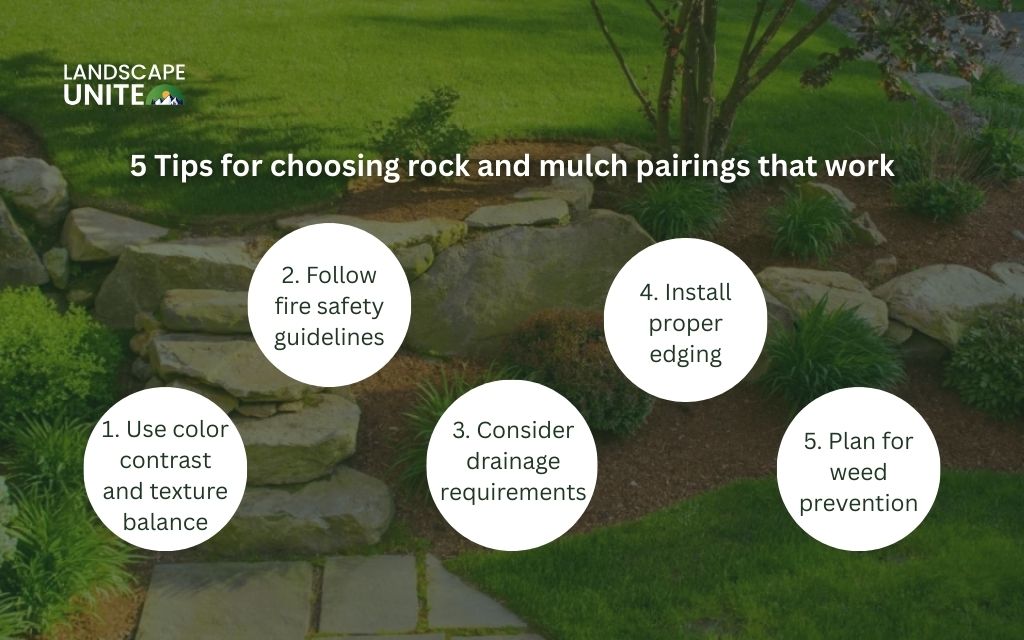
4. Install proper edging
Create clean separation between rock and mulch areas using metal, plastic, or stone edging. This prevents materials from mixing and maintains the designed appearance over time.
5. Plan for weed prevention
Install landscape fabric under rock mulch in high-weed areas. Organic mulch naturally suppresses weeds when applied 3-4 inches thick, so additional barriers may not be necessary.
Conclusion
Rock and mulch landscaping ideas offer practical solutions for modern homeowners seeking beautiful, sustainable outdoor spaces. These designs work across different U.S. climate zones, from arid southwestern regions to humid southeastern areas.
Whether you’re dealing with steep slopes, fire safety concerns, or simply want to reduce annual maintenance, combining rock and organic mulch materials provides the versatility you need. Each of these 10 landscaping ideas with mulch and rocks can be adapted to your specific site conditions and personal style preferences.
At Landscape Unite, we provide expert guidance on landscaping, hardscaping, and gardening techniques that work for real homeowners. Our blog delivers practical information to help you create outdoor spaces you’ll love for years to come.
Ready to start your rock mulch transformation? Subscribe to the Landscape Unite blog for more great landscaping tips and discover new posts that will inspire your next outdoor project. For professional design and installation services, visit Mile High Lifescape to connect with experienced landscape contractors in your area.
FAQs about rock mulch landscaping ideas
Does rock mulch get too hot in summer?
Yes, dark-colored rock mulch can become quite hot during summer months. Choose lighter-colored stones and plant heat-tolerant species to minimize this effect. For professional guidance on material selection for your climate, read more of our detailed blog posts on climate-appropriate landscaping.
Can you mix rock and mulch in the same yard?
Absolutely. Use clear edging materials to separate different zones and prevent materials from mixing. This approach gives you the benefits of both materials in appropriate areas of your landscape.
Does rock mulch attract termites?
Rock mulch does not attract termites since it provides no food source or shelter. This makes it an excellent choice near building foundations where termite prevention is important.
Should I put topsoil under mulch?
Yes, quality topsoil provides essential nutrients for plant growth. Apply 2-3 inches of topsoil before adding either organic or rock mulch for best results. For specific soil preparation techniques, visit our blog for comprehensive guides on soil improvement methods.

